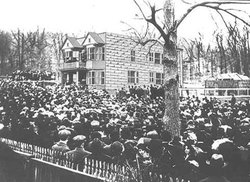History-- Post-War Economy and Progressive Movement
|
* Home
* History * Population * Government * Politics * Lobbyists * Taxes * State Symbols * Biographies * Economy * Employers * Real Estate * Education * Recreation * Restaurants * Hotels * Health * Environment * Stadiums/Teams * Theaters * Historic Villages * Historic homes * Battlefields/Military * Lighthouses * Art Museums * History Museums * Wildlife * Climate * Zoos/Aquariums * Beaches * National Parks * State Parks * Amusement Parks * Waterparks * Swimming holes * Arboretums More... * Gallery of images and videos * Fast Facts on key topics * Timeline of dates and events * Anthology of quotes, comments and jokes * Links to other resources |
-- Emergence of organized labor
Before the Civil War, workers had begun to form labor unions to strengthen their position in bargaining for better wages and working conditions. In 1864, while the Civil War continued, one of the first unions, the Longshoremen's Union Protective Association, was founded to organize dockworkers in the port of New York, but it was later dissolved in the face of stiff opposition from shippers. Most of the other early unions also failed under the pressure of management opposition and post-War recessions that created high levels of unemployment and weakened labor. After the War, New Jersey resumed the rapid industrialization which had slowed during the conflict. Its factories relied on a renewed supply of immigrant labor, supplemented at the lower end of the job scale by freed slaves who emigrated in large numbers from the South. The willingness of New Jersey politicians to solicit economic development of all types also brought new investment, with the state known for its weak laws on how owners raised financing and managed their operations. Working conditions were harsh, and eventually workers attempted to join together to improve their working conditions and strengthen demand for higher wages. In 1879, the Federation of Trades & Labor Unions of New Jersey was founded, with its initial goal the enactment of factory safety and labor laws, including requiring installation of fire escapes; better ventilation at workplaces; and restrictions on employing children. The labor movement also sought legislation to mandate education for all children, thus constraining their availability as laborers. The unions also organized politically to achieve their ends, seeking electoral reforms to weaken the control of political bosses. In 1892, the state Federation affiliated with the American Federation of Labor created by Samuel Gompers, thereby joining the national labor coalition. Yet the labor movement in New Jersey would have difficulty in overcoming divisions between its factions. The trades and crafts represented by the state and national federations would resist joining with the industrial unions composed largely of factory workers who formed the Congress of industrial Organizations. It was not until 1961 that the trade and industrial unions respectively represented by the AFL and the CIO combined their separate organizations into the national and state AFL-CIO--the last state in the nation to do so. -- Progressive movement Toward the end of the nineteenth century, the pressure for reform in New Jersey and the nation took the form of the Progressive movement, with advocates in each party pressing for change in regulating the economy, ending the abuse of monopoly power, improving workplace conditions, opening up the electoral process and combatting corruption. Nationally, leaders like William Jennings Bryan of Nebraska, Robert La Follette of Wisconsin and Theodore Roosevelt of New York led efforts to enact a range of state and federal laws to secure their goals. In New Jersey, after Governor Woodrow Wilson's election in 1910, the New Jersey State Federation of Labor was able to pass the nation’s first effective workmen’s compensation law. And the Federation continued winning victories, including legalizing the right to organize and bargain collectively, raising wages and shortening work hours, banning child labor, and increasing workplace health and safety laws. In 1939, New Jersey’s second labor federation, the Industrial Union Council, was formed. And it was on September 25, 1961 when more than 3,000 union members packed into a Newark armory to watch as the two organizations formally came together to create the New Jersey State AFL-CIO. Before the Civil War, workers had begun to form labor unions to strengthen their position in bargaining for better wages and working conditions. Most of these early unions failed under the pressure of management opposition and post-War recessions that created high levels of unemployment and weakened labor solidarity. In 1879, however, the New Jersey State Labor Congress was founded, and in 1883 it succeeded in obtaining enactment of the first New Jersey law protecting the right to organize labor unions. With the emergence of organized labor, issues such as child labor, workplace safety and the minimum wage became increasingly frequent topics for public debate, but it would not be until the next century that New Jersey took effective action to improve the lot of the average worker.  Strike meeting outside the Botto House in Paterson. Image: American Labor Museum Strike meeting outside the Botto House in Paterson. Image: American Labor Museum
-- Paterson Silk Strike
In 1913, some 25,000 workers at Paterson silk mills shut down the textile industry for six months in an effort to get a minimum daily wage of twelve dollars, an eight-hour work day and a limit in the number of looms assigned to each worker. On February 25, the first day of the strike, the Industrial Workers of the World's prominent feminist leader Elizabeth Gurley Flynn was arrested after giving a talk on uniting strikers across racial boundaries, with the police charging her and other speakers with inciting violence through radical speech. The bitter strike resulted in five deaths in violent clashes with security forces retained by company management, and the blacklisting of some 2,000 workers for their alleged leadership roles in the confrontation. Although the strikers largely failed to achieve their goals, the public attention drawn to the strikers' demands and the harsh conditions of the factory workplace soon would help to generate both federal and State government legislation to establish minimum standards for pay, hours and workplace safety. * Paterson, New Jersey: America's Silk City, National Park Service * Botto House, American Labor Museum |

|